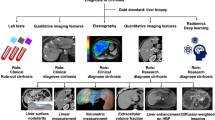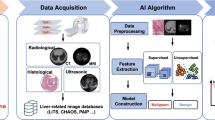Abstract
Background
Although MR elastography allows for quantitative evaluation of liver stiffness to assess chronic liver diseases, it has associated drawbacks related to additional scanning time, patient discomfort, and added costs.
Objective
To develop a machine learning model that can categorically classify the severity of liver stiffness using both anatomical T2-weighted MRI and clinical data for children and young adults with known or suspected pediatric chronic liver diseases.
Materials and methods
We included 273 subjects with known or suspected chronic liver disease. We extracted data including axial T2-weighted fast spin-echo fat-suppressed images, clinical data (e.g., demographic/anthropomorphic data, particular medical diagnoses, laboratory values) and MR elastography liver stiffness measurements. We propose DeepLiverNet (a deep transfer learning model) to classify patients into one of two groups: no/mild liver stiffening (<3 kPa) or moderate/severe liver stiffening (≥3 kPa). We conducted internal cross-validation using 178 subjects, and external validation using an independent cohort of 95 subjects. We assessed diagnostic performance using accuracy, sensitivity, specificity and area under the receiver operating characteristic curve (AuROC).
Results
In the internal cross-validation experiment, the combination of clinical and imaging data produced the best performance (AuROC=0.86) compared to clinical (AuROC=0.83) or imaging (AuROC=0.80) data alone. Using both clinical and imaging data, the DeepLiverNet correctly classified patients with accuracy of 88.0%, sensitivity of 74.3% and specificity of 94.6%. In our external validation experiment, this same deep learning model achieved an accuracy of 80.0%, sensitivity of 61.1%, specificity of 91.5% and AuROC of 0.79.
Conclusion
A deep learning model that incorporates clinical data and anatomical T2-weighted MR images might provide a means of risk-stratifying liver stiffness and directing the use of MR elastography.





Similar content being viewed by others
References
Chalasani N, Younossi Z, Lavine JE et al (2018) The diagnosis and management of nonalcoholic fatty liver disease: practice guidance from the American Association for the Study of Liver Diseases. Hepatology 67:328–357
Lavanchy D (2009) The global burden of hepatitis C. Liver Int 29:74–81
Tapper EB, Lok AS-F (2017) Use of liver imaging and biopsy in clinical practice. N Engl J Med 377:756–768
Serai SD, Trout AT, Miethke A et al (2018) Putting it all together: established and emerging MRI techniques for detecting and measuring liver fibrosis. Pediatr Radiol 48:1256–1272
Smith AD, Porter KK, Elkassem AA et al (2019) Current imaging techniques for noninvasive staging of hepatic fibrosis. AJR Am J Roentgenol 213:77–89
Banerjee R, Pavlides M, Tunnicliffe EM et al (2014) Multiparametric magnetic resonance for the non-invasive diagnosis of liver disease. J Hepatol 60:69–77
Dillman JR, Heider A, Bilhartz JL et al (2015) Ultrasound shear wave speed measurements correlate with liver fibrosis in children. Pediatr Radiol 45:1480–1488
Yin M, Glaser KJ, Talwalkar JA et al (2015) Hepatic MR elastography: clinical performance in a series of 1,377 consecutive examinations. Radiology 278:114–124
Shi Y, Guo Q, Xia F et al (2014) MR elastography for the assessment of hepatic fibrosis in patients with chronic hepatitis B infection: does histologic necroinflammation influence the measurement of hepatic stiffness? Radiology 273:88–98
Joshi M, Dillman JR, Singh K et al (2018) Quantitative MRI of fatty liver disease in a large pediatric cohort: correlation between liver fat fraction, stiffness, volume, and patient-specific factors. Abdom Radiol 43:1168–1179
DiPaola FW, Schumacher KR, Goldberg CS et al (2017) Effect of Fontan operation on liver stiffness in children with single ventricle physiology. Eur Radiol 27:2434–2442
Rotemberg V, Palmeri M, Nightingale R et al (2011) The impact of hepatic pressurization on liver shear wave speed estimates in constrained versus unconstrained conditions. Phys Med Biol 57:329
Trout AT, Sheridan RM, Serai SD et al (2018) Diagnostic performance of MR elastography for liver fibrosis in children and young adults with a spectrum of liver diseases. Radiology 287:824–832
Serai SD, Towbin AJ, Podberesky DJ (2012) Pediatric liver MR elastography. Dig Dis Sci 57:2713–2719
Muthupillai R, Lomas D, Rossman P et al (1995) Magnetic resonance elastography by direct visualization of propagating acoustic strain waves. Science 269:1854–1857
Bahl M, Barzilay R, Yedidia AB et al (2018) High-risk breast lesions: a machine learning model to predict pathologic upgrade and reduce unnecessary surgical excision. Radiology 286:810–818
Dawes TJW, de Marvao A, Shi W et al (2017) Machine learning of three-dimensional right ventricular motion enables outcome prediction in pulmonary hypertension: a cardiac MR imaging study. Radiology 283:381–390
Kickingereder P, Bonekamp D, Nowosielski M et al (2016) Radiogenomics of glioblastoma: machine learning-based classification of molecular characteristics by using multiparametric and multiregional MR imaging features. Radiology 281:907–918
Wu H, Deng Z, Zhang B et al (2016) Classifier model based on machine learning algorithms: application to differential diagnosis of suspicious thyroid nodules via sonography. AJR Am J Roentgenol 207:859–864
Abajian A, Murali N, Savic LJ et al (2018) Predicting treatment response to intra-arterial therapies for hepatocellular carcinoma with the use of supervised machine learning — an artificial intelligence concept. J Vasc Interv Radiol 29:850–857
Kline TL, Korfiatis P, Edwards ME et al (2017) Performance of an artificial multi-observer deep neural network for fully automated segmentation of polycystic kidneys. J Digit Imaging 30:442–448
Mutasa S, Chang PD, Ruzal-Shapiro C, Ayyala R (2018) MABAL: a novel deep-learning architecture for machine-assisted bone age labeling. J Digit Imaging 31:513–519
He L, Li H, Dudley JA et al (2019) Machine learning prediction of liver stiffness using clinical and T2-weighted MRI radiomic data. AJR Am J Roentgenol 213:1–10
LeCun Y, Bengio Y, Hinton G (2015) Deep learning. Nature 521:436–444
Lakhani P, Sundaram B (2017) Deep learning at chest radiography: automated classification of pulmonary tuberculosis by using convolutional neural networks. Radiology 284:574–582
Serai SD, Dillman JR, Trout AT (2016) Spin-echo echo-planar imaging MR elastography versus gradient-echo MR elastography for assessment of liver stiffness in children and young adults suspected of having liver disease. Radiology 282:761–770
Sawh MC, Newton KP, Goyal NP et al (2020) Normal range for MR elastography measured liver stiffness in children without liver disease. J Magn Reson Imaging 51:919–927
Yin M, Talwalkar JA, Glaser KJ et al (2007) Assessment of hepatic fibrosis with magnetic resonance elastography. Clin Gastroenterol Hepatol 5:1207–1213
Simonyan K, Zisserman A (2014) Very deep convolutional networks for large-scale image recognition. Cornell University. https://arxiv.org/abs/1409.1556. Accessed 19 May 2020
ImageNet (2016) Website. http://www.image-net.org/. Accessed 19 May 2020
He K, Zhang X, Ren S, Sun J (2016) Deep residual learning for image recognition. Proceedings of the IEEE Conference on Computer Vision and Pattern Recognition, pp 770–778
Szegedy C, Vanhoucke V, Ioffe S et al (2016) Rethinking the inception architecture for computer vision. Proceedings of the IEEE Conference on Computer Vision and Pattern Recognition, pp 2818–2826
Zoph B, Vasudevan V, Shlens J, Le QV (2018) Learning transferable architectures for scalable image recognition. Proceedings of the IEEE Conference on Computer Vision and Pattern Recognition, pp 8697–8710
Kingma DP, Ba J (2014) Adam: a method for stochastic optimization. Cornell University. https://arxiv.org/abs/1412.6980. Accessed 19 May 2020
Krizhevsky A, Sutskever I, Hinton GE (2012) Imagenet classification with deep convolutional neural networks. Advances in Neural Information Processing Systems. https://doi.org/10.1145/3065386
Selvaraju RR, Das A, Vedantam R et al (2016) Grad-CAM: why did you say that? Cornell University. https://arxiv.org/abs/1611.07450. Accessed 19 May 2020
Olden JD, Jackson DA (2002) Illuminating the “black box”: a randomization approach for understanding variable contributions in artificial neural networks. Ecol Model 154:135–150
Ng A (2017) Machine learning yearning. eBook
Szegedy C, Liu W, Jia Y et al (2015) Going deeper with convolutions. Proceedings of the IEEE Conference on Computer Vision and Pattern Recognition, pp 1–9
Pickhardt PJ, Malecki K, Hunt OF et al (2017) Hepatosplenic volumetric assessment at MDCT for staging liver fibrosis. Eur Radiol 27:3060–3068
Acknowledgments
This study was supported by an internal grant from the Department of Radiology, Cincinnati Children’s Hospital Medical Center.
Author information
Authors and Affiliations
Corresponding author
Ethics declarations
Conflicts of interest
None
Additional information
Publisher’s note
Springer Nature remains neutral with regard to jurisdictional claims in published maps and institutional affiliations.
Rights and permissions
About this article
Cite this article
Li, H., He, L., Dudley, J.A. et al. DeepLiverNet: a deep transfer learning model for classifying liver stiffness using clinical and T2-weighted magnetic resonance imaging data in children and young adults. Pediatr Radiol 51, 392–402 (2021). https://doi.org/10.1007/s00247-020-04854-3
Received:
Revised:
Accepted:
Published:
Issue Date:
DOI: https://doi.org/10.1007/s00247-020-04854-3




